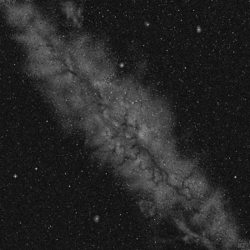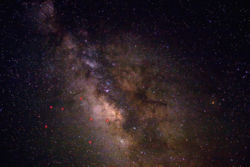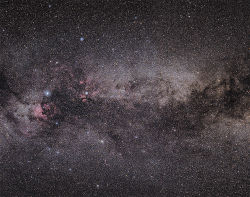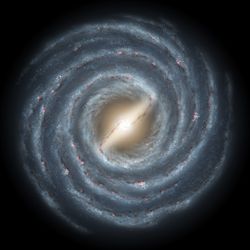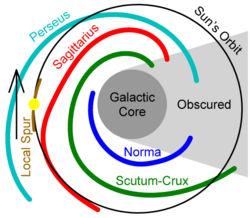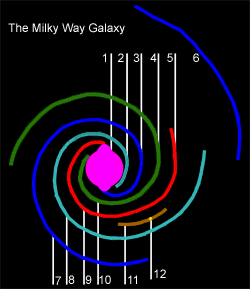Milky Way
2007 Schools Wikipedia Selection. Related subjects: Space (Astronomy)
The Milky Way (a translation of the Latin Via Lactea, in turn derived from the Greek Γαλαξίας (Galaxias), sometimes referred to simply as " the Galaxy"), is a barred spiral galaxy of the Local Group. Although the Milky Way is but one of billions of galaxies in the universe, the Galaxy has special significance to humanity as it is the home of the Solar System. Democritus (450 BC–370 BC) was the first known person to claim that the Milky Way consists of distant stars.
The term "milky" originates from the hazy band of white light appearing across the celestial sphere visible from Earth, which is comprised of stars and other material lying within the galactic plane. The galaxy appears brightest in the direction of Sagittarius, towards the galactic centre. Relative to the celestial equator, the Milky Way passes as far north as the constellation of Cassiopeia and as far south as the constellation of Crux, indicating the high inclination of Earth's equatorial plane and the plane of the ecliptic relative to the galactic plane.The fact that the Milky Way divides the night sky into two roughly equal hemispheres indicates that the solar system lies close to the galactic plane.
The main disk of the Milky Way Galaxy is about 80,000 to 100,000 light-years in diameter, about 250,000 to 300,000 light-years in circumference, and outside the Galactic core, about 1,000 light-years in thickness. It is composed of 200 to 400 billion stars . As a guide to the relative physical scale of the Milky Way, if the galaxy were reduced to 130 km (80 mi) in diameter, the solar system would be a mere 2 mm (0.08 in) in width. The Galactic Halo extends out to 250,000 to 400,000 light-years in diameter. As detailed in the Structure section below, new discoveries indicate that the disk extends much farther than previously thought.
The Milky Way's absolute magnitude, which cannot be measured directly, is assumed by astronomical convention to be −20.5, although other authors give an absolute magnitude of -21.3.
Age
The age of the Galaxy is currently estimated to be about 13.6 billion years, which is nearly as old as the Universe itself.
This estimate is based upon research performed in 2004 by a team of astronomers: Luca Pasquini, Piercarlo Bonifacio, Sofia Randich, Daniele Galli, and Raffaele G. Gratton. The team used the UV-Visual Echelle Spectrograph of the Very Large Telescope to measure, for the first time, the beryllium content of two stars in globular cluster NGC 6397. This allowed them to deduce the elapsed time between the rise of the first generation of stars in the entire Galaxy and the first generation of stars in the cluster, at 200 million to 300 million years. By including the estimated age of the stars in the globular cluster (13.4 ± 0.8 billion years), they estimated the age of the Galaxy at 13.6 ± 0.8 billion years.
Structure
As of 2005, the Milky Way is thought to comprise a large barred spiral galaxy of Hubble type SBbc (loosely wound barred spiral). As of 2006, the Milky Way's mass is thought to be about 5.8×1011 M☉ comprising 200 to 400 billion stars. Its integrated absolute visual magnitude has been estimated to be -21.3.
It was only in the 1980s that astronomers began to suspect that the Milky Way is a barred spiral rather than an ordinary spiral, which observations in 2005 with the Spitzer Space Telescope have since confirmed, showing that the galaxy's central bar is larger than previously suspected.
The galactic disk, which bulges outward at the galactic centre, has an estimated diameter of about 100,000 light-years. The distance from the Sun to the galactic centre is now estimated at 26,000 ± 1400 light-years while older estimates could put our parent star as far as 35000 light-years from the central bulge.
The galactic centre harbors a compact object of very large mass (named Sagittarius A*), strongly suspected to be a supermassive black hole. Most galaxies are believed to have a supermassive black hole at their centre.
As is typical for many galaxies, the distribution of mass in the Milky Way is such that the orbital speed of most stars in the galaxy does not depend strongly on its distance from the centre. Away from the central bulge or outer rim, the typical stellar velocity is between 210 and 240 km/s. Hence the orbital period of the typical star is directly proportional only to the length of the path travelled. This is unlike in the solar system where different orbits are also expected to have significantly different velocities associated with them, and is one of the major pieces of evidence for the existence of dark matter.
The galaxy's bar is thought to be about 27,000 light-years long, running through the center of the galaxy at a 44 ± 10 degree angle to the line between our sun and the centre of the galaxy. It is composed primarily of red stars, believed to be ancient. The bar is surrounded by a ring called the "5- kpc ring" that contains a large fraction of the molecular hydrogen present in the galaxy and most of the Milky Way's star formation activity. Viewed from the Andromeda Galaxy, it would be the brightest feature of the Milky Way
Each spiral arm describes a logarithmic spiral (as do the arms of all spiral galaxies) with a pitch of approximately 12 degrees. There are believed to be four major spiral arms which all start at the Galaxy's centre. These are named as follows, according to the image at right:
- 2 and 8 - 3k pc and Perseus Arm
- 3 and 7 - Norma and Cygnus Arm (Along with a newly discovered extension - 6)
- 4 and 10 - Crux and Scutum Arm
- 5 and 9 - Carina and Sagittarius Arm
There are at least two smaller arms or spurs, including:
- 11 - Orion Arm (which contains the solar system and the Sun - 12)
Outside of the major spiral arms is the Outer Ring or Monoceros Ring, a ring of stars around the Milky Way proposed by astronomers Brian Yanny and Heidi Jo Newberg, which consists of gas and stars torn from other galaxies billions of years ago.
The galactic disk is surrounded by a spheroid halo of old stars and globular clusters approximately 250,000 to 400,000 light-years in diameter. While the disk contains gas and dust obscuring the view in some wavelengths, the spheroid component does not. Active star formation takes place in the disk (especially in the spiral arms, which represent areas of high density), but not in the halo. Open clusters also occur primarily in the disk.
Most of the mass of the Milky Way is thought to be dark matter, forming a dark matter halo of an estimated 600-3000 billion solar masses (M☉) which is concentrated towards the Galactic Centre.
Recent discoveries have given added dimension to our knowledge of the structure of the Milky Way. With the discovery that the disc of the Andromeda Galaxy (M31) extends much further than previously thought, the possibility of the disk of the Milky Way extending further is apparent, and this is supported by evidence of the newly discovered Outer Arm extension of the Cygnus Arm. With the discovery of the Sagittarius Dwarf Elliptical Galaxy came the discovery of a ribbon of galactic debris as the polar orbit of Sagittarius and its interaction with the Milky Way tears it apart. Similarly, with the discovery of the Canis Major Dwarf Galaxy, a ring of galactic debris from its interaction with the Milky Way encircles the galactic disk.
On January 9, 2006 Mario Juric and others of Princeton University announced that the Sloan Digital Sky Survey of the northern sky has found a huge and diffuse structure (spread out across an area around 5,000 times the size of a full moon) within the Milky Way that does not seem to fit within our current models. The collection of stars rises close to perpendicular to the plane of the spiral arms of the Milky Way. The proposed likely interpretation is that a dwarf galaxy is merging with the Milky Way. This galaxy is tentatively named the Virgo Stellar Stream and is found in the direction of Virgo about 30,000 light-years away.
On May 9, 2006, Daniel Zucker and Vasily Belokurov announced that the Sloan Digital Sky Survey has discovered two dwarf galaxies towards the constellations Canes Venatici and Boötes.
The Sun's place in the Milky Way
The Sun (and therefore the Earth and Solar System) may be found close to the inner rim of the Orion Arm, in the Local Fluff, at a distance of 7.94±0.42 kpc from the Galactic Centre. The distance between the local arm and the next arm out, the Perseus Arm, is about 6,500 light-years. Our Sun, and thus the solar system, is found in what scientists call the galactic habitable zone.
The Apex of the Sun's Way, or the solar apex, refers to the direction that the Sun travels through space in the Milky Way. The general direction of the sun's galactic motion is towards the star Vega near the constellation of Hercules, at an angle of roughly 86 degrees to the direction of the Galactic Centre. The sun's orbit around the galaxy is expected to be roughly elliptical with the addition of perturbations due to the galactic spiral arms and non-uniform mass distributions.
It takes the solar system about 225-250 million years to complete one orbit (a galactic year), and so is thought to have completed about 20-25 orbits during its lifetime or 0.0008 orbit since the origin of humans. The orbital speed of the solar system is 217 km/s, i.e. 1 light-year in ca. 1400 years, and 1 AU in 8 days.
The Milky Way environment
The Milky Way and the Andromeda Galaxy are a binary system of giant spiral galaxies. Together with their companion galaxies they form the Local Group, a group of some 50 closely bound galaxies. The Local Group is part of the Virgo Supercluster.
The Milky Way is orbited by two smaller galaxies and a number of dwarf galaxies in the Local Group. The largest of these is the Large Magellanic Cloud with a diameter of 20,000 light-years. It has a close companion, the Small Magellanic Cloud. The Magellanic Stream is a peculiar streamer of neutral hydrogen gas connecting these two small galaxies. The stream is thought to have been dragged from the Magellanic Clouds in tidal interactions with the Milky Way. Some of the dwarf galaxies orbiting the Milky Way are Canis Major Dwarf (the closest), Sagittarius Dwarf Elliptical Galaxy, Ursa Minor Dwarf, Sculptor Dwarf, Sextans Dwarf, Fornax Dwarf, and Leo I Dwarf. The smallest Milky Way dwarf galaxies are only 500 light-years in diameter. These include Carina Dwarf, Draco Dwarf, and Leo II Dwarf. There may still be undetected dwarf galaxies, which are dynamically bound to the Milky Way. Observations through the zone-of-avoidance are frequently detecting new distant and nearby galaxies. Some galaxies consisting mostly of gas and dust may also have evaded detection so far.
In January 2006, researchers reported that the heretofore unexplained warp in the disk of the Milky Way has now been mapped and found to be a ripple or vibration set up by the Large and Small Magellanic Clouds as they circle the Milky Way, causing vibrations at certain frequencies when they pass through the edges of our Galaxy. Previously, these two galaxies, at around 2% of the mass of the Milky Way, were considered too small to influence the Milky Way. However, by taking into account dark matter, the movement of these two galaxies creates a wake that influences the larger Milky Way. Taking dark matter into account results in an approximately twenty-fold increase in mass for the Milky Way. This calculation is according to a computer model made by Martin Weinberg of the University of Massachusetts, Amherst. In this model, the dark matter is spreading out from the Milky Way disk with the known gas layer. As a result, the model predicts that the gravitational impact of the Magellanic Clouds is amplified as they pass through the Milky Way.
Speed through space
In the general sense, the absolute speed of any object through space is not a meaningful question according to Einstein's Special Theory of Relativity, which declares that there is no "preferred" inertial frame of reference in space with which to compare the galaxy's motion. (Motion must always be specified with respect to another object.)
With this in mind, many astronomers believe the galaxy is moving through space at approximately 600km per second relative to the observed locations of other nearby galaxies. Most recent estimates range from 130 km/s to 1,000 km/s. If indeed the Milky Way is moving at 600 km per second, we are travelling 51.84 million km per day, or more than 18.9 billion km per year. For comparison, this would mean that each year, we are travelling about 4.5 times the distance that Pluto lies from the Earth (at its closest). The Milky Way is thought to be moving in the direction of the constellation Hydra, and may someday become a close-knit member of the Virgo cluster of galaxies. Our galaxy may also collide with the Andromeda galaxy in roughly 4 billion years. See below.
Another reference frame is provided by the CMB. The Milky Way is moving at around 552 km/s with respect to the photons of the cosmic microwave background. This can be observed by satellites such as COBE and WMAP as a dipole contribution to the CMB, as photons in equilibrium at the CMB frame get blue-shifted in the direction of the motion and red-shifted in the opposite direction.
Mythology
There are many creation myths around the world regarding the Milky Way. In particular, there are two similar ancient Greek stories that explain the etymology of the name Galaxies (Γαλαξίας) and its association with milk (γάλα). Some myths associate the constellation with a herd of cattle whose milk gives the sky its blue glow. In Eastern Asia, people believed that the hazy band of stars was the " Silvery River" of Heaven. This is written in hanzi as 銀河.
Akashaganga is the Indian name for the Milky Way Galaxy, which means Ganges River of the Sky.
According to Greek mythology, the Milky Way was formed by Hera, who spilled milk in the sky after discovering that Zeus had tricked her into feeding young Heracles. In another variant, Hermes snuck Heracles into Olympus to drink from the breasts of Hera who was asleep. Heracles bit Hera's nipple shooting her milk into the skies forming the Milky Way.
In Finnish mythology the Milky Way was called pathway of the birds ( Finnish: Linnunrata; Estonian: Linnutee). The Finns observed that the migratory birds used the galaxy as a guideline to travel south, where they believed Lintukoto (bird home) resided. Only later the scientists indeed confirmed the observation correct; the migratory birds use the Milky Way as a guide and dwell the winters in warm, southern lands. The Milky Way is even today called Linnunrata in the Finnish language. The name in the Baltic languages has the same meaning ( Lithuanian: Paukščių Takas; Latvian: Putnu Ceļš.
In Swedish, the Milky Way is known as Vintergatan (winter street), for apparent reasons; it is most visible in the winter in Scandinavia.
Ancient Armenian mythology called the Milky Way the "Straw Thief's Way", relating to one of the gods stealing straw and attempting to flee across the heavens in a wooden chariot, spilling some of the straw along the way.
In Hindu mythology the galaxy is called the s'is'umara cakra: the dolphin disc. Looking in the night sky one recognized the band of stars as the belly of a dolphin.
In Slovene, the galaxy is called Rimska cesta, literally "The Roman Road" (or "The Road to Rome", alluding to the ancient pilgrim path). Sometimes, infrequently, it is also called Mlečna cesta, which is a literal translation of its Greek/Latin name. i.e. "Milky Way".
In the Iberian peninsula, the galaxy is known as Road to Santiago (Spanish: Camino de Santiago; Portuguese: Estrada de Santiago; Catalan: Camí de Santiago), alluding to the ancient pilgrim road to the Galician town of Santiago de Compostela, in Spain. Equivalents to Milky Way also exist in the three languages (Spanish and Portuguese: Via Láctea; Catalan: Via Làctia).
Future of the Milky Way
Current measurements suggest the Andromeda Galaxy is approaching us at 300 kilometers per second, and that the Milky Way might collide with it in several (3-4) billion years, depending on the importance of unknown lateral components to the galaxies' relative motion. If they do collide, it is thought that our sun and the other stars of the Milky Way will probably not collide with the stars of Andromeda, but that the two galaxies will merge to form a single elliptical galaxy over the course of about a billion years.

